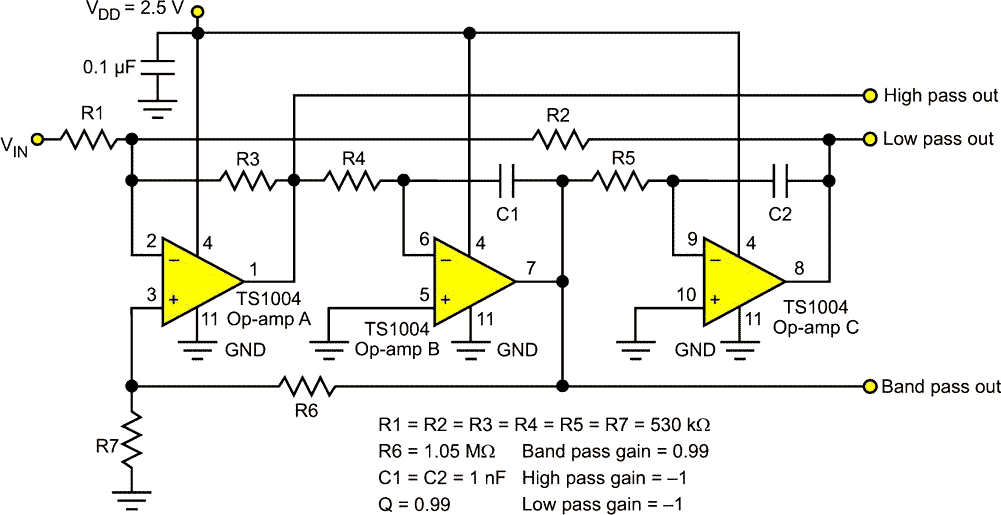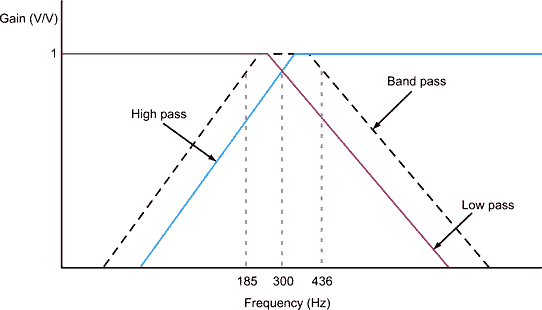Javier Solorzano, Touchstone Semiconductor
Electronic Design
Filters are used in many applications to remove unwanted frequency components from incoming signals, enhance incoming signals, or both. In portable and non-portable medical applications, for example, the heart-rate functionality must detect a range of frequencies. Similarly, handheld communication products like walkie-talkies must be able to monitor multiple tones.
In these and other applications, the combination of a low pass, high pass, and band pass filter is very useful where the quality factor (Q), the gain, and the cutoff frequency of the circuit can be set separately. A state variable filter can be used. With a single low-power quad opamp IC, an integrated, low-power state variable filter that consumes less than 3 µA can be implemented to achieve multiple design objectives using only three of the four available op amps.
 |
|
| Figure 1. | This state variable filter with a TS1004 quad op-amp IC circuit minimizes printed-circuit board (PCB) space while saving power. |
Figures 1 and 2 show the complete circuit design and frequency response of a state variable filter with an op amp. In this case, a Touchstone Semiconductor TS1004 low-power quad op amp was selected.
 |
|
| Figure 2. | This state variable filter frequency response shows a low pass, high pass, and band pass filter. |
The state variable filter offers an independent selection of the Q factor, pass band gain, and cutoff frequency of the circuit. In addition, high pass, low pass, and band pass outputs are available concurrently. The gain of each filter can be set independently where the gain of the band pass filter is the state variable filter’s overall Q factor. To design the circuit, we used Equation 1 where R = R1 = R2 = R3 = R4 = R5 = R7 = 530 kΩ, as well as Equations 2, 3, and 4.
| (1) |
Low pass and high pass corner frequency,
 |
(2) |
| (3) |
| (4) |
By substituting the component values shown in Figure 1 into Equations 1 through 4, the low pass and high pass filter sections have a gain of approximately –1 and the band pass filter section has a gain of approximately 0.99. Thus, the overall Q factor is also 0.99. The cutoff frequency for the low pass and the high pass filter section is approximately 300 Hz. The pass band of the band pass filter section is approximately 251 Hz from approximately 185 Hz to 436 Hz.
With three of the four op amps in use, the entire circuit consumes only 3 µA of supply current! To minimize variations in section gain, Q, and cutoff frequency, 1% tolerance resistors are recommended. Since the op amp has a gain bandwidth product of 4 kHz, increasing filter section gain will reduce the bandwidth of the individual filter sections accordingly.
Being able to integrate a low pass, high pass, and band pass section in a single circuit with the ability to design each section separately is useful in many applications such as heart monitors, audio equalizers, alarm systems, and portable communication devices. A state variable filter offers integration and flexibility by providing low pass, high pass, and band pass sections simultaneously with the ability to design the Q, the gain, and the cutoff frequency separately. Using a low-power quad op amp to design a state variable filter provides an integrated and simple low-power solution with a total circuit supply current of only 3 µA.
